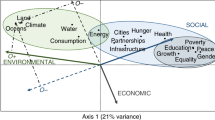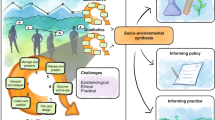Abstract
The integrated nature of the Sustainable Development Goals (SDGs) presents a challenge to implementing the 2030 Agenda. Analytical methods to support decision-makers are often developed without explicitly incorporating decision-makers’ views and experience. Here, we investigate whether existing methods are fit-for-purpose in supporting decision-makers at national and subnational levels. We identify prominent methods for SDG interaction analysis, which we then evaluate by engaging directly (via a survey and interviews) with method developers and decision-makers in Sweden. We find that decision-makers prioritize methods that are simple and flexible to apply and able to provide directly actionable and understandable results. They are less concerned with the accuracy, precision, completeness or quantitative nature of the knowledge. Prominent categories of methods include self-assessment, expert judgement, literature-based, statistical analyses and modelling. Interviewed decision-makers consider these methods in line with the features prioritized in the survey but highlight low performance on features they value highly, such as the extent to which results are actionable and overall ease of use. Methods developers have limited awareness of decision-makers’ priorities and requirements, so hindering methodological advancement. They should focus on the practical value of applications to support decision-makers, resource-constrained organizations and those seeking to evaluate multiple cases.
This is a preview of subscription content, access via your institution
Access options
Access Nature and 54 other Nature Portfolio journals
Get Nature+, our best-value online-access subscription
$29.99 / 30 days
cancel any time
Subscribe to this journal
Receive 12 digital issues and online access to articles
$119.00 per year
only $9.92 per issue
Buy this article
- Purchase on Springer Link
- Instant access to full article PDF
Prices may be subject to local taxes which are calculated during checkout



Similar content being viewed by others
Data availability
Data of the review of the literature and practice of SDG interaction research are available in the Supplementary Data and the source data for Fig. 1. Source data are provided with this paper. Additional data are available from the corresponding author on reasonable request.
References
Transforming our World: The 2030 Agenda for Sustainable Development (United Nations, 2015); http://www.un.org/ga/search/view_doc.asp?symbol=A/RES/70/1&Lang=E
Griggs, D. et al. An integrated framework for Sustainable Development Goals. Ecol. Soc. 19, 49 (2014).
Breuer, A., Janetschek, H. & Malerba, D. Translating Sustainable Development Goal (SDG) interdependencies into policy advice. Sustainability 11, 2092 (2019).
Bennich, T., Weitz, N. & Carlsen, H. Deciphering the scientific literature on SDG interactions: a review and reading guide. Sci. Total Environ. 728, 138405 (2020).
Allen, C., Metternicht, G. & Wiedmann, T. National pathways to the Sustainable Development Goals (SDGs): a comparative review of scenario modelling tools. Environ. Sci. Policy 66, 199–207 (2016).
Miola, A., Borchardt, S., Neher, F. & Buscaglia, D. Interlinkages and Policy Coherence for the Sustainable Development Goals Implementation (European Union, 2019).
Johnsson, F., Karlsson, I., Rootzén, J., Ahlbäck, A. & Gustavsson, M. The framing of a Sustainable Development Goals assessment in decarbonizing the construction industry – avoiding “greenwashing”. Renew. Sustain. Energy Rev. 131, 110029 (2020).
van Soest, H. L. et al. Analysing interactions among Sustainable Development Goals with Integrated Assessment Models. Glob. Transit. 1, 210–225 (2019).
Allen, C., Metternicht, G. & Wiedmann, T. Priorities for Science to Support National Implementation of the Sustainable Development Goals: A Review of Progress and Gaps (Monash Sustainable Development Institute, 2021).
Sachs, J. et al. Sustainable Development Report 2020: The Sustainable Development Goals and COVID-19 (Cambridge Univ. Press, 2020).
Colledge, L. & Verlinde, R. Scival Metrics Guidebook (Elsevier, 2014).
Climate, Land (Food), Energy and Water Systems Approach—CLEWs (Royal Institute of Technology, 2020).
Messerli, P. et al. Expansion of sustainability science needed for the SDGs. Nat. Sustain. 2, 892–894 (2019).
Talwar, S., Wiek, A. & Robinson, J. User engagement in sustainability research. Sci. Public Policy 38, 379–390 (2011).
Weichselgartner, J. & Kasperson, R. Barriers in the science-policy-practice interface: toward a knowledge-action-system in global environmental change research. Glob. Environ. Change 20, 266–277 (2010).
Cash, D. W. et al. Knowledge systems for sustainable development. Proc. Natl Acad. Sci. USA 100, 8086–8091 (2003).
Norström, A. V. et al. Principles for knowledge co-production in sustainability research. Nat. Sustain. 3, 182–190 (2020).
Allen, C., Metternicht, G. & Wiedmann, T. Initial progress in implementing the Sustainable Development Goals (SDGs): a review of evidence from countries. Sustain. Sci. 13, 1453–1467 (2018).
SDG Impact Assessment Tool (Gothenburg Centre for Sustainable Development, 2021).
Government Agencies and the 2030 Agenda (GD-Forum, 2020); https://www.folkhalsomyndigheten.se/gd-forum-agenda-2030/english/
Glokala Sverige—Agenda 2030 i Kommuner och Regioner (United Nations Association Sweden, 2020); https://fn.se/vi-gor/utveckling-och-fattigdomsbekampning/agenda-2030/glokala-sverige/
CONCORD Sweden (CONCORD Sweden, 2020).
UN Global Compact—Participants (UN Global Compact, 2020).
Swedish Investors for Sustainable Development and the SDGs (SIDA, 2019).
Municipal Initiatives within Agenda 2030 (SKR, 2019).
Regional Initiatives within Agenda 2030 (SKR, 2019).
Framework to Review Models (UK National Audit Office, 2016).
Louviere, J. J. & Woodworth, G. G. Best-Worst Scaling: A Model for the Largest Difference Judgments (Univ. of Alberta, 1991).
Orme, B. Maxdiff Analysis: Simple Counting, Individual-level Logit, and HB (Sawtooth Software, 2009).
Olfe-Kräutlein, B. Advancing CCU technologies pursuant to the SDGs: a challenge for policy making. Front. Energy Res. https://doi.org/10.3389/fenrg.2020.00198 (2020).
Weitz, N., Carlsen, H., Nilsson, M. & Skånberg, K. Towards systemic and contextual priority setting for implementing the 2030 Agenda. Sustain. Sci. 13, 531–548 (2018).
Nilsson, M., Griggs, D. & Visbeck, M. Policy: map the interactions between Sustainable Development Goals. Nature 534, 320–322 (2016).
Nilsson, M. et al. Mapping interactions between the Sustainable Development Goals: lessons learned and ways forward. Sustain. Sci. 13, 1489–1503 (2018).
SDG Synergies: An Approach for Coherent 2030 Agenda implementation (Stockholm Environmental institute, 2020).
Fuso Nerini, F. et al. Connecting climate action with other Sustainable Development Goals. Nat. Sustain. 2, 674–680 (2019).
Nerini, F. F. et al. Mapping synergies and trade-offs between energy and the Sustainable Development Goals. Nat. Energy 3, 10–15 (2018).
Vinuesa, R. et al. The role of artificial intelligence in achieving the Sustainable Development Goals. Nat. Commun. 11, 233 (2020).
Roy, J., Some, S., Das, N. & Pathak, M. Demand side climate change mitigation actions and SDGs: literature review with systematic evidence search. Environ. Res. Lett. 16, 043003 (2021).
Castor, J., Bacha, K. & Fuso Nerini, F. SDGs in action: a novel framework for assessing energy projects against the Sustainable Development Goals. Energy Res. Soc. Sci. 68, 101556 (2020).
de Almeida, C. M. L., Bergqvist, E., Thacker, S. & Nerini, F. F. Actions to align energy projects with the Sustainable Development Goals. Discov. Sustain. 2, 16 (2021).
Kroll, C., Warchold, A. & Pradhan, P. Sustainable Development Goals (SDGs): are we successful in turning trade-offs into synergies? Palgrave Commun. 5, 140 (2019).
Pradhan, P., Costa, L., Rybski, D., Lucht, W. & Kropp, J. P. A systematic study of Sustainable Development Goal (SDG) interactions. Earth’s Future 5, 1169–1179 (2017).
Collste, D., Pedercini, M. & Cornell, S. E. Policy coherence to achieve the SDGs: using integrated simulation models to assess effective policies. Sustain. Sci. 12, 921–931 (2017).
Pedercini, M., Zuellich, G., Dianati, K. & Arquitt, S. Toward achieving Sustainable Development Goals in Ivory Coast: simulating pathways to sustainable development. Sustain. Dev. 26, 588–595 (2018).
iSDG—Integrated Simulation Tool (Millennium Institute, 2021).
IMAGE Model 3.0 Model Documentation (Netherlands Environmental Assessment Agency, 2020); https://models.pbl.nl/image/index.php/Welcome_to_IMAGE_3.0_Documentation
van Vuuren, D. P. et al. Pathways to achieve a set of ambitious global sustainability objectives by 2050: explorations using the IMAGE integrated assessment model. Technol. Forecast. Soc. Change 98, 303–323 (2015).
Ramos, E. P. et al. The climate, land, energy, and water systems (CLEWs) framework: a retrospective of activities and advances to 2019. Environ. Res. Lett. 16, 033003 (2021).
Engström, R. E. et al. Cross-scale water and land impacts of local climate and energy policy—a local Swedish analysis of selected SDG interactions. Sustainability 11, 1847 (2019).
Acknowledgements
We thank all who collaborated with us on the data collection. We acknowledge the representative of Sweden’s national coordinator for the 2030 Agenda for the support with the engagement of decision-makers. This research was funded by NERC grant no. NE/S012834/1 (L.D. and R.S.) and Formas grant no. 2019-00040 (L.D. and J.K.) under the research initiative Towards a Sustainable Earth: Environment–Human Systems and the UN Global Goals.
Author information
Authors and Affiliations
Contributions
L.D., R.S. and J.K. designed the research. L.D. collected and analysed the data and was the primary writer. All authors edited the manuscript.
Corresponding author
Ethics declarations
Competing interests
The authors declare no competing interests.
Additional information
Peer review information Nature Sustainability thanks Francesco Fuso Nerini and the other, anonymous, reviewer(s) for their contribution to the peer review of this work.
Publisher’s note Springer Nature remains neutral with regard to jurisdictional claims in published maps and institutional affiliations.
Supplementary information
Supplementary Information
Supplementary Sections 1–5, Figs. 1–7 and Tables 1–7.
Supplementary Data
Results of the search of methods in the practice of SDG decision-making.
Source data
Source Data Fig. 1
Published records identified in the scientific literature.
Source Data Fig. 2
Citation networks of prominent methods identified in the scientific literature.
Rights and permissions
About this article
Cite this article
Di Lucia, L., Slade, R. & Khan, J. Decision-making fitness of methods to understand Sustainable Development Goal interactions. Nat Sustain 5, 131–138 (2022). https://doi.org/10.1038/s41893-021-00819-y
Received:
Accepted:
Published:
Issue Date:
DOI: https://doi.org/10.1038/s41893-021-00819-y
This article is cited by
-
Beyond synergies: understanding SDG trade-offs, equity and implementation challenges of sectoral climate change mitigation options
Sustainability Science (2024)
-
Returning to core principles to advance the 2030 Agenda
Nature Sustainability (2023)



